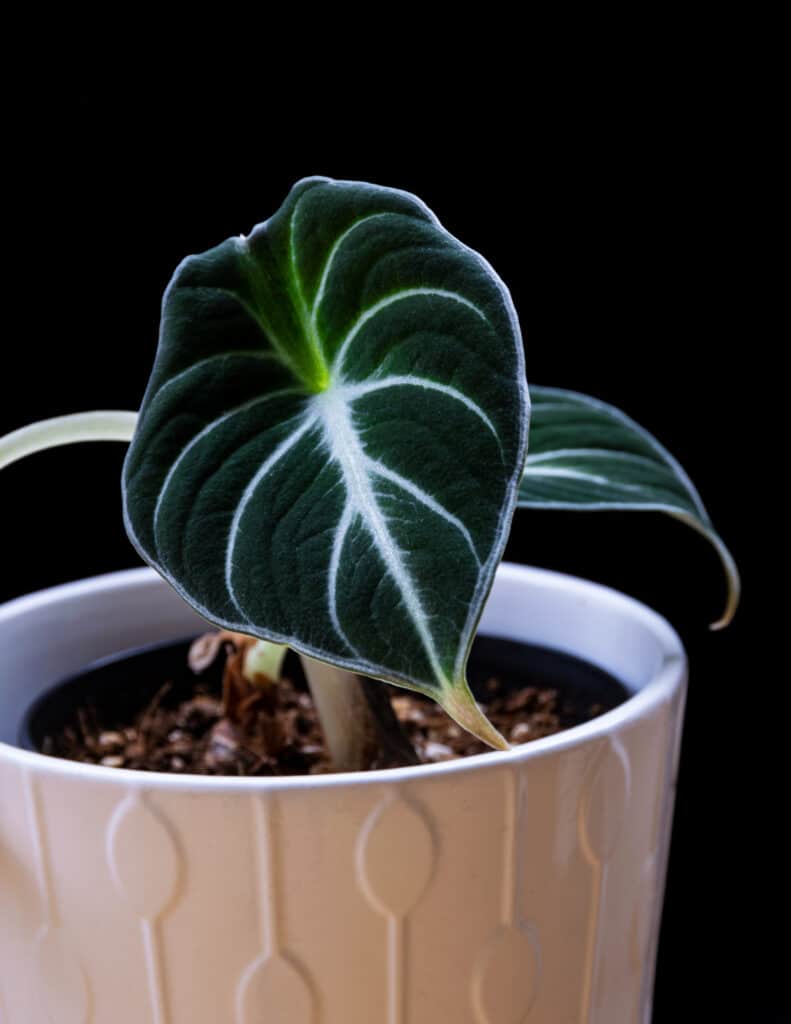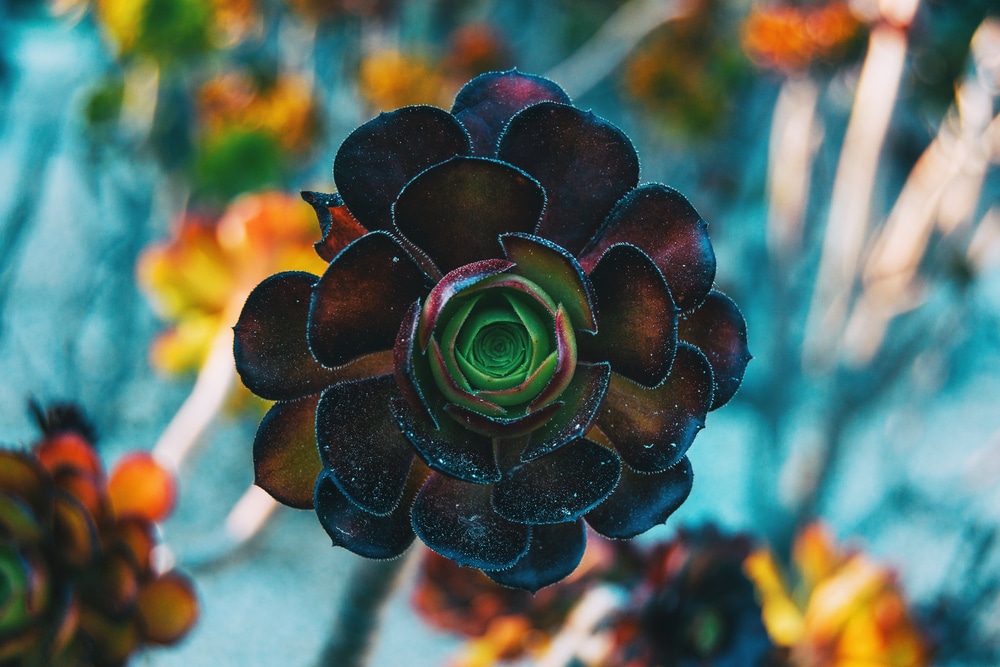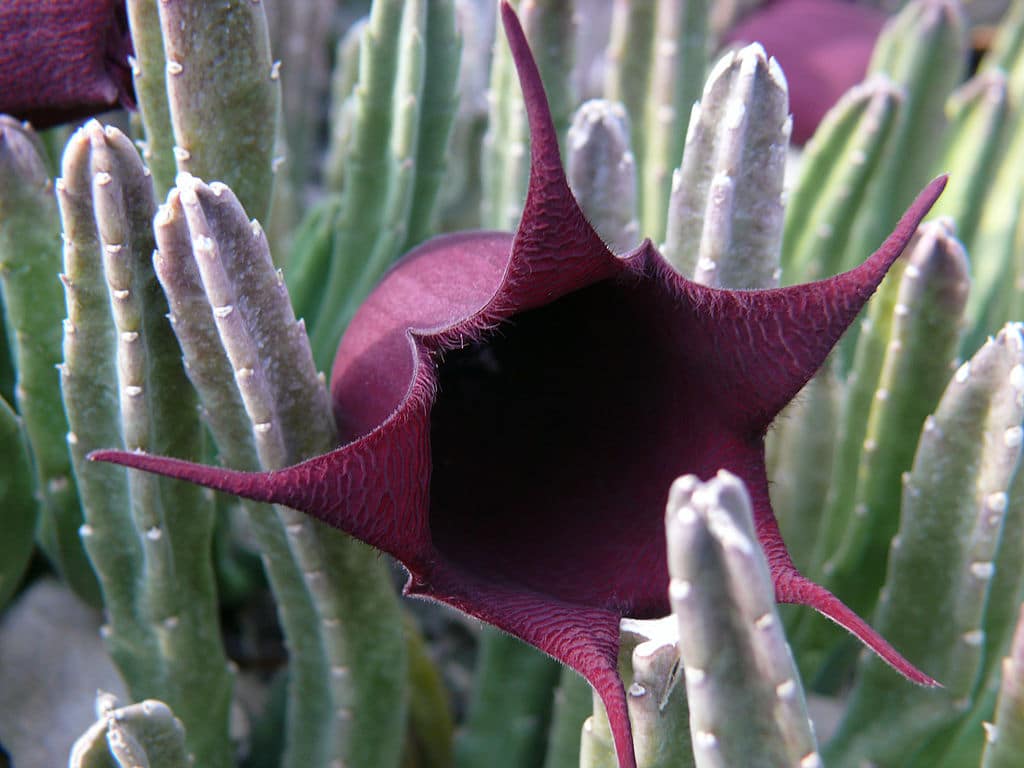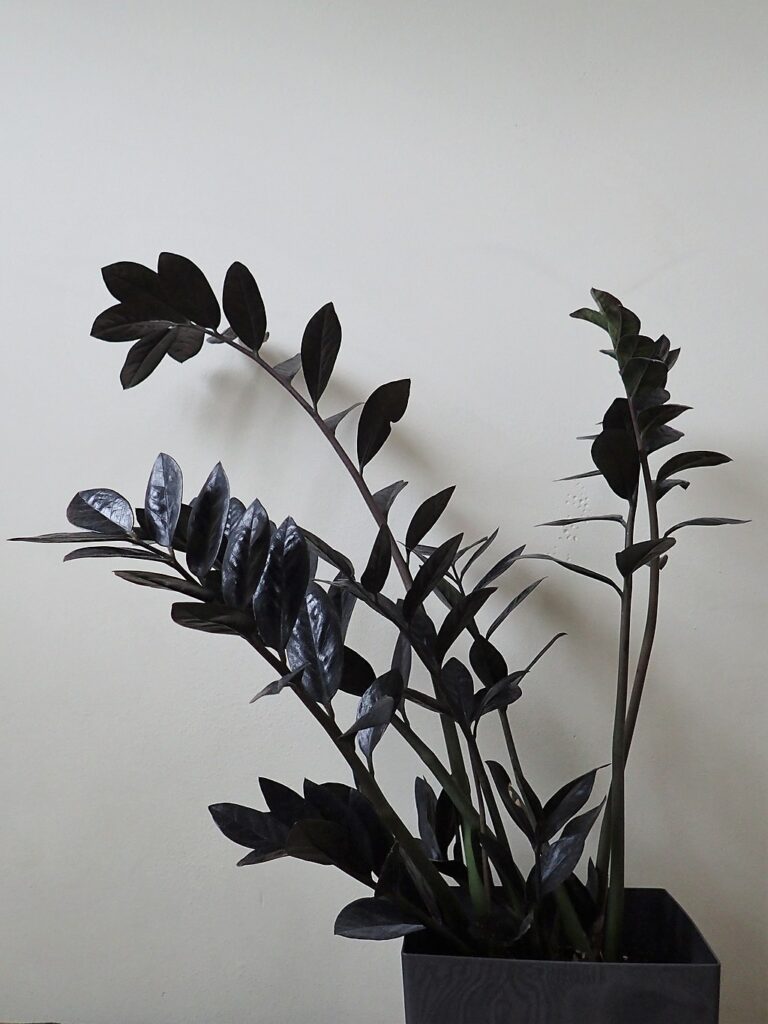Colorful houseplants are great and they definitely have their place – but sometimes you want something a little darker. Whether you are looking for a little gothic chic or simply wish to contrast in interesting ways with other colorful plants in the house, this post is for you!
In this article we’ll tell you about 15 deliciously dark houseplants that can add a unique look to your house and are sure to spark conversation.
While black plants are very uncommon in nature, there are several options out there that fit the bill or are close enough to color coordinate with some of your darker décor.
Let’s take a look and you can see for yourself!
Black Houseplants That You Can Keep at Home
- Rubber plant – Ficus Elastica ‘Black Prince’
- Black Velvet – Alocasia reginula
- Black Magic – Colocasia esculenta
- ‘Black Rose’ Aeonium – Aeonium Arboreum ‘Zwartkop’
- Black Hens and Chicks – Sempervivum tectorum ‘Black’
- Black Bells – Stapelia leendertziae
- Raven ZZ plant – Zamioculcas zamiifolia ‘Black’
- Black Prince Coleus – Plectranthus scutellarioides, Coleus ‘Black Prince’
- Black Haworthia – Haworthia nigra
- Black Devil Pansy – Viola x wittrockiana
- Black Sweet Potato vines – Ipomoea batatas ‘Blackie’
- Chinese Jade – Sinocrassula yunnanensis ‘Black’
- Peperomia Metallica – Peperomia Metallica ‘Columbiana’
- Black Fancy Begonias – Begonia ‘Black Fancy’
- Burgundy Ripple Peperomia – Peperomia caperata “Red Ripple/Red Burgundy”
Rubber plant – Ficus Elastica ‘Black Prince’
Rubber plants are easy to take care of, but you’re probably used to seeing the standard green variety. There is one type of rubber plant, however, that is quite a bit darker than the rest. We’re talking about the ‘Black Prince’ variety, which is also known as ‘Burgundy’ in some planting circles.
The name comes from the deep burgundy leaves which they have which are dark enough to make them very close to black. If placed in the house next a number of dark items or on a black surface, this Rubber plant will fit right in.
Be prepared to trim it from time to time, as Rubber plants grow fast. When raised indoors, they can grow up to 30 feet unchecked!
For soil, you want good drainage – a mix of potting soil with 1 part perlite and 1 part peat moss is just about perfect.
Bright, indirect sunlight is best. If the leaves start looking a bit dull then it needs more light. Water it thoroughly every 6 to 7 days, with the goal being to keep the soil moist but not soaked.
Black Velvet – Alocasia reginula

The Black Velvet has beautiful, dark leaves that border on the black along with silver veining that really contrasts the dark color. This plant will grow to around 15 inches at full maturity with leaves around 6 inches long and 2 inches wide.
This plant is tropical, so it will do best with a little humidity. To this effect, a humidifier or a humidity tray is a good idea. You can also keep it in a bathroom if there’s a window to give it some indirect sunlight.
A good tropical mix such as ABG is a perfect soil for the Black Velvet. This plant prefers bright, indirect sunlight for optimal growth and health.
A typical watering frequency would be 3 times a week in the summer, once a week in the winter, and in the months between you can find the optimal watering frequency by testing the top 2 inches of the soil – if it’s dry, it’s ready to water.
Black Magic – Colocasia esculenta

The Black Magic has dark plum leaves, which are heart-shaped and look completely black from a distance. This is a good ‘show plant’ for a corner, as it can grow to be up to 3 feet tall and extend itself to be 3 feet wide.
For soil, you should mix 2 parts orchid bark, 2 parts perlite, and 1 part potting soil. Bright, indirect sunlight is best and you should water once a week (just enough so that you see drainage begin).
Check the top 2 inches of topsoil to make sure it is dry before you water, as this plant is sensitive to overwatering.
‘Black Rose’ Aeonium – Aeonium Arboreum ‘Zwartkop’

The Black Rose Aeonium is a beautiful succulent. With plenty of sunlight, you’ll get a beautifully symmetric rosette of dark burgundy with a lime-green center.
While they start off small, these plants will grow to be 3 feet when fully mature. As it’s a succulent, they’re also quite easy to care for, which is always a bonus for a beautiful houseplant.
For an easy soil base, mix 2 parts of cactus soil to 1 part perlite and your Aeonium will do well in its new home.
Water it every 7 days, with the exception of the winter months, at which point you should water it every 12 days. If you want it to get that dark burgundy color, it will need full sunlight – a spot in the window is going to be best until it gets cool outside.
Black Hens and Chicks – Sempervivum tectorum ‘Black’
This succulent is a beautiful dark purple color which often border on the side of black. The name comes from the way that it grows, with a large rosette being central (the Hen) surrounded by smaller rosettes (the Chicks). Best of all, you can plant those chicks separately for easy propagation.
These plants start off small and stay that way, ranging between 4 to 6 inches when fully grown.
Succulent or Cactus mix soil will be a perfect fit for this plant. While they prefer to get full sunlight, they will also work with you if you put them in a place that is partially shaded.
Water them once a week, just make sure that the soil is dry first.
Black Bells – Stapelia leendertziae

Black Bells are a South African succulent that grows to around 11 inches in height. From spring to summer it produces large, bell-shaped blooms up to 5 inches in length that range from red to a dark purple that is almost black. The stems of Black Bells will be dull green or red.
It has a few other names that you can look for, such as the Carrion Flower, Star Flower, and the Maroon Cup Starfish.
Succulent or cactus mix soil will work well with Black Bells, but bright, indirect sunlight is best. Watering should be done every 1 to 2 weeks depending on how much sun it is getting. Check the topsoil to ensure that the top 2 inches are dry before adding more water.
Raven ZZ plant – Zamioculcas zamiifolia ‘Black’

One of the darkest plants on the list, the Raven ZZ plant has purple-black leaves much like you’d see on it’s namesake Raven. These low-maintenance plants look amazing and make a good organic showpiece, topping out at a height of 3 to 4 feet when fully matured. They are slow growers, however, so you’ll need to be patient with your Raven – it’ll get there!
The Raven ZZ is a tropical succulent, so standard succulent mix potting soil will be a perfect fit for this plant. Bright, indirect sunlight will help maximize growth, but it is also tolerant of medium and low light levels – just keep in mind that it will grow more slowly in these conditions.
Watering is super easy – water it lightly every 2 weeks until the winter comes, when once a month will suffice. That’s a lot of beauty for very little work, indeed!
Black Prince Coleus – Plectranthus scutellarioides, Coleus ‘Black Prince’
The Black Prince variety of Coleus (and also the Palisandra) have wide, purple-black leaves which sport a hint of red and can grow to be larger than your hands! Before flowering, you’ll get a bit of contrast, as the flower spikes tend to be white and lavender.
Fully matured, this plant will be between 24 to 30 inches tall and about 18 to 24 inches wide. You’ll want to pick a nice, open space for it to fill in your home where you and your guests can always get a good look.
Regular potting soil is fine, provided that it drains well. You might want to add 1 part perlite to help to facilitate this. Bright, indirect sunlight is best, unless you have a spot in the house which only gets sunlight in the morning. It does require more frequent watering than the previous plants we’ve listed, with every 3 days being the optimal watering frequency for your Black Prince.
Black Haworthia – Haworthia nigra
The Black Haworthia can appear dark green to a beautiful black. The spiky leaves are definitely eye-catching and if you give it enough sunlight, you they should blacken up quite nicely – just don’t overdo it.
This is a slow-growing dwarf succulent that will only grow to be 4 to 5 inches at full maturity, but the color will definitely warrant a place as a centerpiece for the dark floral collection in your house.
This succulent likes sandy soil, but a standard Cactus mix will do the trick nicely. It likes partial sunlight, with at least 4 to 6 hours of sunlight in the morning being optimal – though it can still grow quite well in low light levels.
As far as watering, make sure the soil is dry before you water. Watering once a week in the warmer months and once every 2 weeks in the winter should be optimal.
Black Devil Pansy – Viola x wittrockiana
The Black Devil pansy is definitely a looker. With flowers that have velvety black / purple and a bright yellow center, it’s a plant that you’ll want to simply sit and look at almost every day. It’s also quite hardy, being fairly resistant to cold and easy to take care of in the home.
Black Devil Pansies are only about 6 to 9 inches tall when fully mature, but they definitely have a lot of character!
Regular potting soil with a little perlite added should work well for your Black Devil Pansy. These plants like full sunlight. Daily watering is likely to be required, but check the top inch of the soil and only water your plant when this is dry.
Black Sweet Potato vines – Ipomoea batatas ‘Blackie’ or ‘Solar Power Black’
Southeast Asian Sweet Potato vines make a brilliant hanging plant that can grow up to 16 inches tall, 10 feet in length, and have about a 3-6 foot wide spread when fully mature. The leaves are burgundy to black and really quite striking. This is not a good plant if you have children or pets as the leaves and tubers are quite toxic.
Regular potting soil will work just fine for Black Sweet Potato vines and they like at least 6 hours of full sunlight per day, though they can tolerate periods of shade. Watering once per week should be sufficient for keeping this plant in good health.
Chinese Jade – Sinocrassula yunnanensis ‘Black’
The Chinese Jade is a dark succulent that grows in tightly clustered formations. This plant is a great choice for your desk, as it only grows to be about 4 inches tall. You’ll want to keep it close to a window, however, as this succulent definitely loves its sunlight.
A standard cactus mix or succulent soil medium is the best choice for substrate. It likes full sunlight, preferably 6 to 8 hours per day, so be sure that it’s close to a window where it can get as much as possible. The more sunlight it gets, the darker it will become, so this is a must if you want your Chinese Jade to look it’s very darkest.
Watering should be done around once per week, but only if the soil has dried out completely. Depending on where you place it, the frequency will vary. Test the soil to can easily determine the perfect watering schedule for your Chinese Jade.
Peperomia Metallica – Peperomia Metallica ‘Columbiana’
It’s black and red and has quite the heavy-metal name. Peperomia Metallica is easy to take care of and is commonly referred as ‘Red Tree Peperomias’ (in case you have trouble finding this plant online).
The leaves of this plant start off red, with silver veins, and darken as your plant grows. At full maturity, your Peperomia Metallica will only be about 8 inches tall and about 6 inches wide – definitely manageable, beautiful, and unique!
Peperomia Metallica does require a bit of humidity, so a humidity tray or humidifier is going to be a must if you wish to grow this plant.
Potting soil mixed with perlite or sand is going to be best for this plant. It likes direct sunlight, so try to make sure it’s at least 2 feet away from a southern-facing window.
Watering should be done every 1 to 2 weeks – just check the soil and make sure that it dries out completely between each watering.
Black Fancy Begonias – Begonia ‘Black Fancy’
The Black Fancy Begonia has beautiful, medium-sized black leaves. In the spring it will even give you some lovely pink flowers to add some contract. It looks great in a hanging pot or even on a table or shelf.
This plant will grow to be about 10 inches tall and 12 inches wide. The roots of this plant are mildly toxic, so be sure to hang it or place it on a shelf if your pet has a habit of getting into your plants.
A light potting soil mixed with perlite is ideal for Black Fancy Begonias. Bright, indirect sunlight is best.
Watering should typically be done once a week. Test the soil by sticking your finger inside up to the first knuckle – if it has dried out on top, it’s time to water. Water soluble fertilizer once a month during the spring is advisable for optimal growth.
Burgundy Ripple Peperomia – Peperomia caperata “Red Ripple/Red Burgundy”
Our final entry is another Peperomia – while the name is not as cool as ‘Metallica’, the Burgundy Ripple is definitely a desirable plant for decorating your home. While not truly black, it is quite dark, with the leaves being heart-shaped and dark green with a network of purple-red veins throughout.
This plant is also quite compact, with a fully-matured height of approximately 8 inches and a width of 8 inches as well – perfect for a desk, shelf, or even as a kitchen table centerpiece.
Regular potting soil with perlite will make a happy home for your Burgundy Ripple. It’s pretty casual about the light levels – low, medium or even bright light is fine, provided that it is indirect. As far as watering, you should water this plant approximately every 7 to 10 days, allowing the top half of the soil to dry out between waterings for best results.
Some Closing Words
Today we’ve taken look at some of the darkest houseplant options on the market – of which there are definitely some beauties! If you decide to take one or more home with you, it wouldn’t hurt to ask the nursery for tips. Once you’ve gotten used to their care, each and every one of these plants is very manageable.
You’ll see for yourself soon, they create quite the interesting atmosphere!

